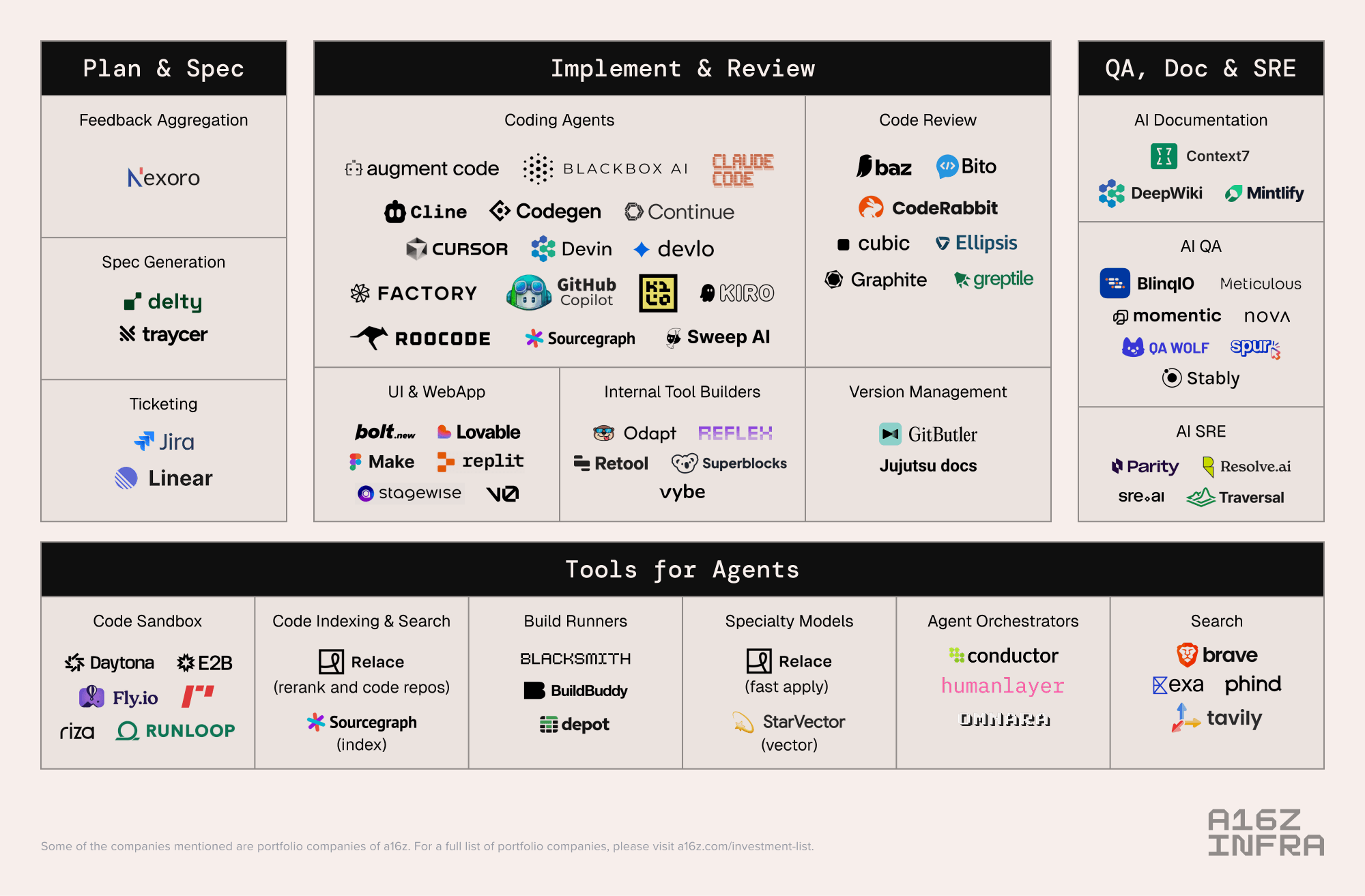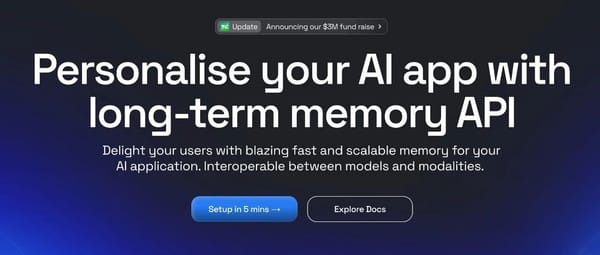# The Trillion-Dollar AI Software Development Stack

🎙 Listen to Guido and Yoko discuss the **trillion-dollar AI software development stack** on:
- [Apple Podcasts](https://podcasts.apple.com/us/podcast/the-trillion-dollar-ai-software-development-stack/id1740178076?i=1000731186101)
- [Spotify](https://open.spotify.com/episode/7HmrrFtFuPUybTuvZCpJ4p)
---
## Why AI in Software Development Is a Massive Opportunity
Generative AI has made its biggest initial impact in **software development** — a sector not historically considered a top-tier software category by market size. This change makes sense for two reasons:
1. **Developers build tools for themselves first.**
2. **The total addressable market is enormous.**
**By the Numbers**:
- Currently, between **27M** ([Evans Data](https://evansdata.com/press/viewRelease.php?pressID=365)) and **47M** ([SlashData](https://www.slashdata.co/research/developer-population)) developers worldwide.
- Assuming $100k economic value per developer annually → **$3 trillion potential economic impact**.
- Early AI coding assistants may boost productivity by **~20%**.
- Advanced AI could **double productivity**, equating to GDP gains the size of **France**.
---
## Market Momentum
Startups and tech giants are aggressively investing:
- **Cursor** → [$500M ARR, $10B valuation in 15 months](https://cursor.com/blog/series-c)
- **Google** → $2.4B Windsurf acquisition (talent-focused)
- **Anthropic** → Claude Code launch
- **OpenAI** → GPT‑5 launch focused entirely on coding
We’ve entered the **“Warring States Period”** of AI software development.
---
## Spotlight: AiToEarn Platform
[AiToEarn](https://aitoearn.ai/) is an **open-source global AI content monetization platform** that enables creators to:
- Generate AI-driven content
- Publish across multiple platforms simultaneously
- Analyze performance
- Rank AI models ([Model Rankings](https://rank.aitoearn.ai))
**Tools Connected**: AI content generation → cross-platform publishing → analytics → monetization.
More resources: [Blog](https://blog.aitoearn.ai) | [Documentation](https://docs.aitoearn.ai)
---
## From Single-Track AI Coding to Full AI Development Ecosystems
Modern AI-assisted programming is now an **ecosystem** capable of supporting dozens of billion-dollar companies, potentially birthing trillion-dollar giants.
Key shifts:
- **AI accelerates development** and **models become building blocks**.
- Market size expands via [Jevons Paradox](https://en.wikipedia.org/wiki/Jevons_paradox):
- Lower cost → higher demand → larger total market.
---
## Emerging AI Coding Workflow: Plan → Code → Review
**Old Model (18 Months Ago):**
- Request code snippet from LLM → paste into source.
**New Model:**
1. **Plan** → Detailed feature description
2. **Code** → Generated via agent loop, possibly with testing
3. **Review** → Developer verifies and adjusts
Benefits:
- High-quality specifications
- Continuous documentation updates
- Cooperation between human developers and LLMs
---

**Planning Stage Highlights**:
- AI drafts high-level spec
- AI requests necessary clarifications, keys, and permissions
- Specs guide implementation and preserve long-term codebase understanding
---
## Architecture & Coding Rules for AI
Modern AI systems often include:
- **Project-specific rules** (e.g., `.cursor/rules`)
- **Company-wide guidelines**
- **Module-specific best practices**
Examples:
- [Awesome Cursor Rules](https://github.com/PatrickJS/awesome-cursorrules)
- [Claude Code Plugins](https://github.com/brennercruvinel/CCPlugins)
---
## Planning Tools Ecosystem
**Feedback Aggregation**:
- Examples → [Nexoro](https://nexoro.ai/) (forums, Slack, CRM data)
**Specification Breakdown**:
- [Delty](https://www.delty.ai/)
- [Traycer](https://traycer.ai/)
- Integrations with tools like [Linear](https://linear.app/)
Existing systems like wikis and trackers will likely need **full transformation or replacement**.
---
## Code Generation & Review
Types of AI development interactions:
1. **Chat-Based File Editing**
- Works across codebases with large context
- Integrated in IDEs or web UIs
2. **Background Agents**
- Operate autonomously using tests
- Output via code trees or PRs
- Examples: [Devin](https://app.devin.ai/), [Claude Code](https://www.anthropic.com/claude-code), [Cursor Background Agents](https://docs.cursor.com/background-agent)
3. **AI App Builders & Prototyping**
- Lovable, Bolt/Stackblitz, Vercel v0, Replit
- Build full functional apps from prompts or wireframes
4. **Version Control for AI Agents**
- Tools like [Gitbutler](https://gitbutler.com/) shift focus from `diffs` → intent tracking
5. **SCM Integration**
- AI reviews PRs/issues for correctness, security, compliance
- Examples: [Graphite](https://graphite.dev/), [CodeRabbit](https://www.coderabbit.ai/)
---
## Special Use Cases
### Legacy Code Migration
- Translate old languages → modern ones
- Process: Spec from old code → verify → new implementation
- Huge enterprise demand
---
### Quality Assurance (QA) & Documentation
- **Docs for humans + LLMs**: Context7, Mintlify
- **Security & compliance docs**: Delve
- **AI QA**: Autonomous tests across UI/API/backend
---
### Agent-Specific Tools
- **Code Search**: RAG tools, Sourcegraph, Relace
- **Web/Doc Search**: Mintlify, Context7, Exa, Brave, Tavily
- **Code Sandboxes**: E2B, Daytona, Morph, Runloop, Together
---
## AI Development Market Map

The full tool ecosystem aligns with the **software development lifecycle**, expanding categories beyond planning, coding, and review.
---
## Economics of AI Tools & Costs
Example Claude Code cost calculation → ~\$2.50 per query:
- **Input**: 100k tokens → \$1.50
- **Output**: 10k tokens → \$0.75
- Extra reasoning tokens → total \$2.25–\$2.50
Annualized → \$10k per developer in heavy usage scenarios.
---
## Impact on Developers & Education
- **AI adoption is accelerating** despite cost concerns
- Companies using AI often **hire more developers**
- University curricula must overhaul courses:
- Algorithms
- Architecture
- Human-computer interaction
---
## Future: Self-Extending Software
- Platforms like [Gumloop](https://www.gumloop.com/) let users describe features and generate implementations automatically.
- Potential for **late binding API calls based on human-language specs**.
- One day, desktop apps could have **“Vibe Code” buttons** to add features live.
---
## Andrej Karpathy's Vision: No-Code High-Level Execution
- Basic tasks → already possible in LLMs
- Complex tasks → code still needed (100B× speed advantage)
---
## Perfect Timing for Startups
Supercycles are the best time to build:
- AI tools accelerate dev cycles → startup advantage
- Market incumbents (e.g., GitHub Copilot) face strong competition
---
## A Historic Software Revolution
- **Greater productivity & capability** for engineers
- **Better software** for end users
- **Ideal moment** to launch a dev-focused startup
---
**a16z** is actively working with companies in this space.
Also see: [AiToEarn官网](https://aitoearn.ai/) — connecting AI content tools, publishing, analytics, monetization across platforms.
---
**Source:** [a16z.com](https://a16z.com/the-trillion-dollar-ai-software-development-stack/?utm_source=chatgpt.com)





